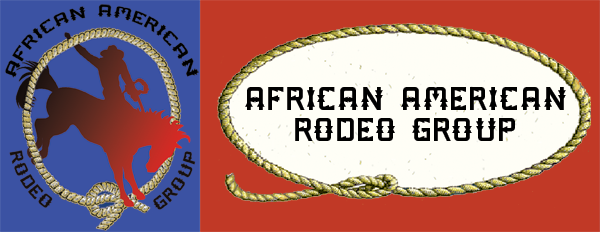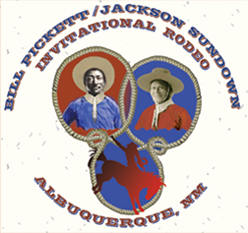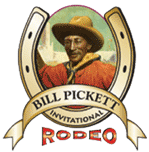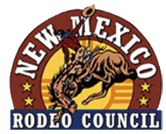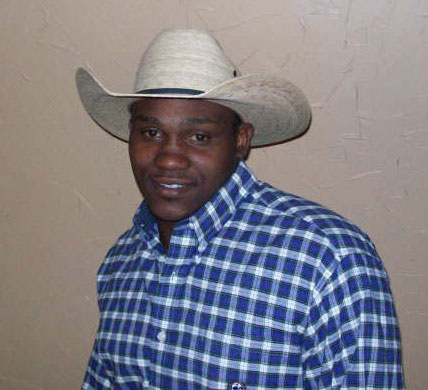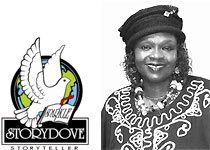| |
Cheryl "Sparkle" Mosley also known, as the "STORY
DOVE" is a professional storyteller, writer, teaching artist,
motivational speaker and workshop facilitator that entertain, educates,
motivates and enlightens all ages for all occasions.
She is a contributing author in the book
entitled "Pot Likker
Stories for Teachers and Learners." Also, she is the playwright/producer
of "Legacies of Courage," a historical dramatic portrayal
of women of courage.
Founder of a youth program that promotes exploration and coping
skills through creativity and self-expression called Story Dove
Creative Connections.
Facilitates and designs workshops to meet specific topics, themes,
curriculum standards, guidelines, overall goals and objectives
and time constraints for schools, organizations, corporations,
etc.
Former producer and host of the Cable TV
show "Express It!" and
the weekly radio show "Story Dove."
Sparkle is the past National President of the National Association
of Black Storytellers, Inc. (NABS) and former State President of
the North Carolina Association of Black Storytellers, Inc. (NCABS).
Sparkle currently resides in Charlotte, NC.
Even the citizens of Marland have forgotten the names of the people buried on nearby
White Eagle Monument Hill. White Eagle, of course is remembered. He was a chief of the Ponca tribe. The Miller Brothers of 101 Ranch fame erected the monument in his name.
Bill Pickett rests here too, a name so well known in rodeo
that rodeo people call the graveyard "Bill Pickett Hill," bestowing upon him
a prominence they feel atones for the disregard of others buried at the site.The grave is marked with a sandstone tombstone that reads: "Bill Pickett-C.S.C.P.A." The letters stand for Cherokee Strip Cow Punchers Association. Pickett, a black man who has been given credit for "inventing"bull
dogging, died in the spring of 1932 after an altercation with a bronco
in a 101 Ranch corral. He was 62.
Pickett worked for the Millers, who not only had the big Oklahoma ranch (the 101) but also a big show (101 Ranch Wild West Show), for most of his adult life. But his remarkable story begins not in Oklahoma but in south central Texas near Taylor, Williamson County.
His antecedents were of mixed "Negro, Caucasian and Cherokee Indian blood," according to Colonel Bailey C. Hanes, "a not uncommon blend [in the 1800's] in the upper south." In his book, Bill Pickett, Bulldogger (University of Oklahoma Press, Norman, 1977), Hanes concludes that "Thomas
Jefferson Pickett was born in Louisiana and was 26 years old in 1880,
which means that one of the Pickett women was pregnant at the time
the wagons headed West and that he was born at some unknown place in
1854 as the caravan passed through Louisiana, "
According to Hanes" research, "the caravan was made up of 48 whites and 52 Negro slaves." Thomas Jefferson Pickett was Bill Pickett's father. He and Bill's mother, Mary, produced13 children. Five of the boys, including Bill, may have been the first black entrepreneurs in Taylor, where they operated a business called "Pickett
Bros. Bronco Busters and Rough
Riders Ass'n."
Bill was born in 1870, five years after the Civil War ended and the slaves of the Confederacy were emancipated. By the time he was 16, he was becoming interested in horses, cattle and dogs.
Not many writers emphasize the influence cattle dogs had on the young
man, but, I believe, if it were not for these dogs, he might never
have been the famous bite 'em style bulldogger he was. There were "heel" dogs and "catch" dogs.
The latter went to a critter's head, while the former harassed the
heels. Cowboys were used to such chases because it was next to impossible
to swing ropes, or make cow catches in the thick tangles of brush that
covered much of Williamson County.
As young Bill watched the cowboys, working on ranches or in holding corrals, he wondered to himself why so many critters got away If they would just do it like they dogs, he must have thought as he and his brothers organized their business: catching and bringing back wild cattle and breaking and gentling wild horses.
Exactly where Bill Pickett first grabbed a steer's lip with his teeth-like the dogs did it-is not known. You hear stories that he did it in the brush, on the range, in a holding No. But wherever he did it, he was the first to do it and the first to be promoted in a specialty act.
In talking to old-timers, much of the fanciful element is reduced. They figure that Pickett went down or! the back of a cow brute, stopped it, then bit into lip or nose and just fell away, dropping the steer by twisting its neck and assisted by the attrition of leverage.
But an "eyewitness account" in the Tulsa World, Oct. It, 1931, described his fear in "shows" (there were no rodeos in those days) like this: "The
steer longed into the arena ... his Pickett's horse plunged full speed
after it . the rider leaped from the saddle. He turned a complete somersault
along the length of the steer's back, flying out and down over the
curved horns... to fasten his teeth in the side of the steer's mouth.
With sheer strength he dragged the running behemoth's head to the tan-bark,
thrust its horn in the ground, and forward momentum threw the steer
hocks over horns in a somersault of its own. "
"He'd be killed or going to the hospital," commented one veteran
rodeoer after I read him
this early account of what Pickett was supposed to have done Before his
death a few years back, Yakima Canutt, one of the best of the pioneer
rodeo gang, told me that "hoolihaning"
was so dangerous to both contestants and stock that it was outlawed, following a rash of injuries and death .
Hoolihaning is described by Ramon F. Adams in Western Words (University of
Oaklahoma Press, Norman, 1944) like this: " The act of leaping forward
and alighting on the horns of a steer in bulldogging in such a manner
as to knock the steer down without having to resort to twisting him down
with a wrestling hold. The practice is barred at practically all recognized
rodeos."
Mrs. William Paxton Irvine once confirmed that "Bill Pickett was riding with my father, Lee Moore, near Thoundale, Texas, in the late 1880's, They were rounding up cattle and one steer was hard to turn. Bill took after the steer and bulldogged it." (How he did this was not elaborated on, but he must have used the bite-'em style because Moore, who had a theatrical bent, booked Pickett in Texas and other states, describing him as a "bulldogger
that did it with his teeth."
In addition to Moore, whose agreement with Pickett ended in 1903, the
black man was "shown" by the promoter Dave McClure, again as
far away from his home turf as Cheyenne and the shows in North Dakota.
His success and notoriety as the "only professional bulldogger in the world," caught
the attention of the Miller Brothers whose 101 Ranch Wild West Show was
fast becoming the best such entertainment in the country. In 1905, they
hired Pickett for his popular act and brought him and his entire family
from Texas to Oklahoma, housing them at 101 Ranch headquarters at Bliss
(now Marland).
Of course, Pickett was on the road a lot, billed as "The Dusky Demon" on
show flyers. When not on the road he did all sorts of chores to help
the sell-sufficiency of the huge ranch. He picked cotton, maintained
fences, built corrals, and broke and gentled horses. He was particularly
good with horses, according to his great grandson Frank Phillips.
" My grandmother, Bessie Pickett Phillips," said Phillips, "told
me a lot about Bill ... how he pretended to be 'the man of steel' but how
he was really hurting, in later years, following work each day.
" I think he was exploited in a way. He was black and yet he was unique
in what he did. But then in those days, all black athletes were exploited
in tine one way or another. . especially prize fighters."
There was the Mexico City incident in 1908 The Millers should have known better, should have anticipated the consequences, when they pitted the Dusky Demon against the fighting bull, Frijoli Chiquita. But they did it anyway and nearly lost their lives as the crowd in the El Toro National Bullring vented its wrath.
Everything the onlookers could lay hands on - cushions, rocks bottles, knives, fruit, cans, etc., were tossed into the ring. (They were outraged at what they considered a burlesque of their national spectacle as Pickett, shaken like a rag doll, just hung on for dear life.)
Frank Phillips seems to think that the intervention of Mexican troops was the only thing that saved them. President Porfirio Diaz was in the stands, and realizing the crowd was fast becoming dangerous and uncontrollable ordered the army to invade the ring and restore order.
Certainly Bill Pickett is one of those colorful characters in the history of Wild West Shows and rodeos. And, therefore, he was inducted into the Rodeo Hall of Fame, Oklahoma City, in 1971, the first black rodeo athlete to be so honored.
BIBLIOGRAPHY: Bailey C. Hanes, Bill Pickett, Bulldogger:
The Biography of a Black Cowboy (Norman: University of Oklahoma Press,
1977). Jerrold J. Mundis ÒHe Took the Bull by the HornsÓ;
American Heritage, December 1967.
©2007 Bill Pickett Invitational Rodeo.
The horse became a very
important part of the Nez Perce people. Not only for hunting in
buffalo country, but the horse was a warrior. Nez Perce learned
to breed and work with horses. Waaya-Tonah-Toesits-Kahn (Jackson
Sundown) from an early age worked and cared for horses. Waaya-Tonah-Toesits-Kahn
was a famous all-around cowboy, horseman, and excellent rider and
breeder of horses.
The Nez Perce War of 1877 began and Waaya-Tonah-Toesits-Kahn was
14 years old. Waaya-Tonah-Toesits-Kahn and Sam Tilden (Suhm-Keen)
both were assigned to attend to the horses in the evening and herd
the horses while the tribe decamped. After the Nez Perce war ended
Waaya-Tonah-Toesits-Kahn retreated to Canada with a small band
of cold, hungry and injured Nez Perce. It is believed that Waaya-Tonah-Toesits-Kahn
stayed with the Sioux (Sitting Bull's camp in Canada) about two
years, then crossed the border into Washington. He then went into
Montana, married and had two daughters.
Waaya-Tonah-Toesits-Kahn became known as Jackson Sundown and developed
a well know reputation as a skilled horseman.
In 1910, Jackson Sundown moved back to Idaho. And in 1912 he
married Cecelia Wapshela, and they lived on her ranch located at
Jacques Spur, six miles east of Lapwai.
Sundown became a well known all-round rodeo rider. Jackson Sundown
was going to rodeos all over the northwest. In 1912 it is recorded
that Jackson Sundown (at the age of 49) entered rodeo events in
Canada and Idaho (Culdesac, Orofino, Kamiah and Grangeville).
Sundown became a favorite at these rodeos because he was tall,
lean and handsome, he wore his hair in braids tied under his chin,
and he always wore bright colored shirts.
In 1914, Sundown was having much success as an all-around rodeo
rider. Other contestants pulled out of rodeos because Sundown
was riding and they knew he would win. As a result the rodeo managers
decided to hire Sundown to exhibition ride for $50.00 a day to
entertain the crowds.
In 1915, Sundown (at age 52) went to Pendleton Oregon and placed
third. Sundown decided to retire from rodeo after the Pendleton
Roundup. In 1916 a sculptor, Alexander Phimister Proctor (who
was sculpting Sundown at the time), persuaded Sundown to enter
the 1916 Roundup in Pendleton, Oregon and paid his entrance fee.
Sundown made it to the saddle bronc semi-final round and then
rode "Casey Jones" to move into the finals with two other cowboys
(Rufus Rollen and Bob Hall). Rollen and Hall both had excellent
rides. As Sundown eased onto Angel's back for his final ride,
the blindfold was removed from Angel. Angel tried to whirl and
leap to throw Sundown off. All Sundown's years as a child in the
Wallowa's riding, and his career in Montana as a horseman, and
his rodeo experience showed that day. It is said that Sundown
became one with the horse. As Angel tried one last attempt at
throwing Sundown off, Sundown fanned his hat at the horse. And
then the signal of the end of the ride. Jackson Sundown, Waaya-Tonah-Toesits-Kahn,
was the 1916 World Champion Bronc Rider.
Sundown made his last public appearance in 1917 for Governor Moses
Alexander.
In 1923, Jackson Sundown died of pneumonia, he was buried at Slickpoo
Mission Cemetery near Jacques Spur. Later a stone monument was
placed there to remember the Nez Perce warrior and horseman Waaya-Tonah-Toesits-Kahn.
The memorial reads:
Jackson Sundown
Waaya-Tonah-Toesits-Kahn
Nez Perce Born in Montana 1863
Died at Jacques Spur, December 18,1923
At the age of 60 years
Jackson Sundown rode with Chief Joseph in 1877.
He performed in many rodeos in the Northwest and Canada. In 1916
he won the World's Championship at Pendleton and an ovation never
before equaled.
Courtesy
of www.nezpearce.org
|
